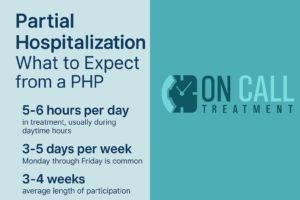Even when you know you need more support, the thought of being “stuck” in treatment all day can stir up doubt. For alumni coming back after a relapse, that fear can feel even heavier—like you’re signing away your life again. It’s easy to picture long hours under fluorescent lights, sitting in a chair until the sun goes down.
But the truth is, a Partial Hospitalization Program (PHP) is structured, but it’s not meant to take over every waking moment. It’s designed to give you concentrated help, while still leaving space for real life—space you can use to practice what you’re learning, reconnect with the world outside, and rebuild your sense of self.
What “Partial” Really Means
The word “partial” in Partial Hospitalization Program isn’t a trick—it’s the point. You’re in treatment for a large part of the day, but you still go home in the evenings.
Most PHP schedules run five to six days a week, typically between 9 a.m. and 3 p.m., though exact hours can vary. That’s enough time for multiple therapy sessions, skills workshops, and breaks, without the intensity (or isolation) of round-the-clock inpatient care.
One alum told us: “It felt like a workday—except my job was to get better.” That’s the heart of it. You’re showing up, putting in the effort, and then taking those skills home the same day to test them in your real environment.
A Typical Day in PHP
While each program has its own flow, here’s what you might expect:
- Morning check-in – A chance to ground yourself, share how you’re feeling, and set intentions for the day.
- Group therapy – Guided conversations about triggers, coping skills, and real-life challenges. These aren’t lectures; they’re interactive and supportive.
- Skills training – Practical exercises for stress management, relapse prevention, and emotional regulation.
- One-on-one sessions – Time with a therapist or counselor to work through personal challenges.
- Breaks and lunch – Built-in pauses so you can rest and recharge.
- Afternoon wrap-up – Reflecting on what you’ve learned and setting goals for your evening.
The pace is steady but manageable, designed to keep you engaged without leaving you drained.
Why PHP Hours Matter After a Relapse
Coming back to treatment after a relapse can feel like you’re walking into a courtroom—waiting for the sentence. But PHP isn’t about punishment.
Those daily hours create a structure that many people lose after leaving full-time treatment. For someone who’s stumbled after 90 days, that structure can feel like a safety net instead of a cage.
By having a set schedule, you eliminate long, unstructured stretches of time that can invite old habits. And because you go home each day, you’re able to re-establish healthy routines in the very environment where you’ll be living your recovery.

Balancing Treatment With Real Life
One of the most powerful parts of PHP is the balance it creates. You have enough time in treatment to make meaningful progress, but enough time outside of it to keep building your life.
You can still:
- Spend evenings with family or supportive friends.
- Keep certain work or school commitments.
- Attend outside recovery meetings.
- Take care of personal responsibilities like cooking, errands, or appointments.
This balance means you’re not just learning recovery skills in theory—you’re putting them into action daily, with your treatment team available to help you process what worked and what didn’t.
PHP vs. Being There “All Day, Every Day”
When people first hear “Partial Hospitalization,” they sometimes imagine a locked facility with 10-hour days and no freedom. That’s not what it is.
Yes, it’s a big commitment. You’re dedicating the better part of your day to your recovery, but it’s for a defined period—often a few weeks to a couple of months—depending on your needs. And every evening, you go home.
Think of it like physical rehab after surgery: the work is concentrated, but you’re not living at the clinic.
Is PHP Right for You Now?
If you’ve relapsed after building some clean time, PHP offers something powerful: it meets you where you are.
It’s more support than once-a-week therapy, but less disruptive than inpatient care. It gives you the intensity you might need right now without cutting you off from your daily life.
For many alumni, PHP has been the bridge between “I can’t do this” and “I’m back on track.”
FAQ: Partial Hospitalization Program in Waltham, MA
1. How long will I need to attend PHP?
The length varies based on your progress and needs. Many people attend for four to six weeks, but your treatment team will adjust the plan with you.
2. Will I be there every single day?
Most PHP programs run five to six days per week. You’ll have at least one day off for rest or outside appointments.
3. Can I work while in PHP?
Some people maintain part-time work, especially in the evenings or on off-days. Your hours in PHP will be a priority, but staff can help you plan a realistic schedule.
4. What if I need more help than PHP?
If your needs go beyond PHP’s level of care, your treatment team can coordinate a transition into a higher level of care, such as inpatient or residential treatment.
5. How is PHP different from Intensive Outpatient (IOP)?
PHP is typically longer hours per day and offers more clinical support. IOP usually meets three to five days per week for fewer hours each day.
6. What happens when I “graduate” from PHP?
Many alumni transition into IOP, outpatient therapy, or community-based recovery supports. The goal is a step-down process that maintains stability while you take on more independence.
Call (833)287-7223 or visit our Partial Hospitalization Program page to learn more about services in Waltham, MA and how we can help you steady your footing.

